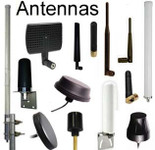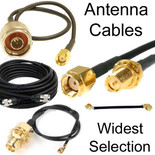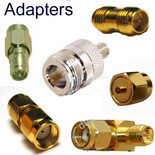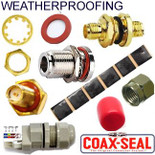Antennas, Antenna Cables, Wireless Products: Technical Articles
Dielectric Materials in Antenna Cables | Signal Loss Impact
Table of Contents
The Role of Dielectric Materials in Coaxial Antenna Cables
Dielectric materials are a key factor in determining the performance characteristics of coaxial cables. These dielectric materials separate the inner conductor from the outer conductor. Understanding the properties of various dielectric materials allows engineers and designers to choose the right cable for their application, optimizing signal integrity, impedance matching, and frequency handling.
This article explores how different dielectric materials influence the performance of coaxial cables, with a focus on signal loss, impedance, and frequency suitability.

Understanding Dielectric Materials
The dielectric material in a coaxial cable is a non-conductive substance that insulates the central conductor from the outer shield. It serves multiple purposes:
Signal Propagation: Facilitates the transmission of RF signals by supporting an electromagnetic field between the conductors.
Impedance Control: Determines the cable’s characteristic impedance, which must match the connected devices to minimize signal reflections.
Signal Loss Reduction: Minimizes energy dissipation as heat or signal leakage.
Common Dielectric Materials
Several dielectric materials are commonly used in coaxial cables, each with unique properties that affect performance.

1. Polyethylene (PE)
Polyethylene is a popular choice due to its low cost and good dielectric properties. Variants include solid, foam, and air-spaced polyethylene.
Solid PE: Offers robustness but higher dielectric constant, leading to greater signal loss.
Foam PE: Reduces the dielectric constant, resulting in lower signal loss and better performance at higher frequencies.
Air-Spaced PE: Minimizes signal loss further by incorporating air gaps but is less durable.
2. Polytetrafluoroethylene (PTFE)
PTFE, commonly known as Teflon, is widely used in high-performance coaxial cables.
Advantages: Low dielectric constant, excellent thermal stability, and low signal loss, especially at high frequencies.
Applications: Ideal for aerospace, military, and high-frequency RF applications.
3. Fluorinated Ethylene Propylene (FEP)
FEP is similar to PTFE but slightly less expensive and more flexible.
Advantages: Low signal loss and high temperature resistance.
Applications: Often used in environments requiring flexible yet durable cables.
4. Polyvinyl Chloride (PVC)
PVC is less common as a dielectric but is sometimes used in budget-friendly cables.
Advantages: Low cost and adequate performance for low-frequency applications.
Limitations: Higher signal loss and unsuitable for high-frequency or precision applications.
Key Factors Affected by Dielectric Materials
1. Signal Loss (Attenuation)
The dielectric constant (εr) of a material significantly impacts signal loss. Materials with lower dielectric constants, such as PTFE and foam PE, exhibit lower signal attenuation. This is particularly important for long cable runs and high-frequency signals.
2. Impedance
The characteristic impedance of a coaxial cable is determined by the dielectric material and the geometry of the conductors. A standard impedance, such as 50 or 75 ohms, is critical for maximizing power transfer and minimizing signal reflections. High-quality dielectric materials ensure stable impedance over a range of frequencies.
3. Frequency Suitability
At higher frequencies, dielectric materials with lower loss tangents perform better, as they reduce energy dissipation. For instance, PTFE is preferred in gigahertz-range applications due to its exceptional performance at high frequencies.
Choosing the Right Dielectric Material
The selection of dielectric material depends on the specific requirements of the application:
High-Frequency Applications: PTFE or foam PE is recommended for minimal signal loss and excellent thermal stability.
Cost-Sensitive Applications: Solid PE or PVC can be used for low-frequency, less critical installations.
Flexible and Harsh Environments: FEP offers a balance of performance and flexibility, making it suitable for dynamic conditions.
Conclusion
Coaxial antenna cables are essential components in modern communication systems, widely used for transmitting radio frequency (RF) signals in applications ranging from television broadcasting to wireless communications and high-speed internet. As technology advances and demands on communication systems increase, the role of innovative dielectric materials will continue to be a key focus in coaxial cable design.
FAQs
What is the dielectric in a coaxial cable and what does it do?
The dielectric is the non-conductive material between the inner conductor and the outer shield. It supports the RF field for signal propagation, sets the cable’s characteristic impedance, and helps reduce signal loss by minimizing energy dissipation.
Why does dielectric choice matter for performance?
Different dielectrics have different dielectric constants (εr) and loss tangents. Lower εr and lower loss tangent generally mean lower attenuation, better high-frequency behavior, and more stable impedance—leading to higher signal integrity.
How does the dielectric affect impedance (50 Ω, 75 Ω, etc.)?
Impedance is determined by both geometry (conductor diameters, spacing) and the dielectric’s εr. For a given geometry, using a material with a different εr will change the resulting impedance and can increase reflections if it doesn’t match the system (e.g., 50 or 75 Ω).
What are the pros and cons of common dielectric materials?
- Solid PE: robust and inexpensive, but higher εr → higher loss; better for low frequencies/cost-sensitive runs.
- Foam PE: lower εr than solid PE → lower loss; good for higher frequencies.
- Air-spaced PE: even lower effective εr → very low loss, but typically less durable.
- PTFE (Teflon): very low loss and excellent thermal stability; ideal for high-frequency, aerospace/military use; higher cost.
- FEP: similar to PTFE but more flexible and usually cheaper; good balance for harsh/flexible installs.
- PVC (as dielectric): lowest cost, but higher loss; suitable only for low-frequency, non-precision uses.
When should I choose PTFE or foam PE over cheaper options?
Use PTFE or foam PE for high-frequency applications or long runs where attenuation and thermal stability are critical. Their lower loss and better high-frequency behavior maintain signal quality and reduce reflections.
How do dielectric properties influence frequency suitability?
At higher frequencies, materials with low loss tangent (e.g., PTFE, foam PE) dissipate less energy, preserving amplitude and phase. Materials with higher losses (e.g., PVC) are unsuitable because attenuation rises quickly as frequency increases.
What practical factors should guide dielectric selection for my project?
Match the system impedance, target the lowest feasible loss for your frequency and run length, consider environment (temperature, flexibility, durability), and balance performance vs. cost. As a rule of thumb:
- High frequency/precision: PTFE or foam PE.
- Cost-sensitive/low frequency: solid PE or (with caution) PVC.
- Flexible/harsh environment: FEP for performance plus flexibility.







